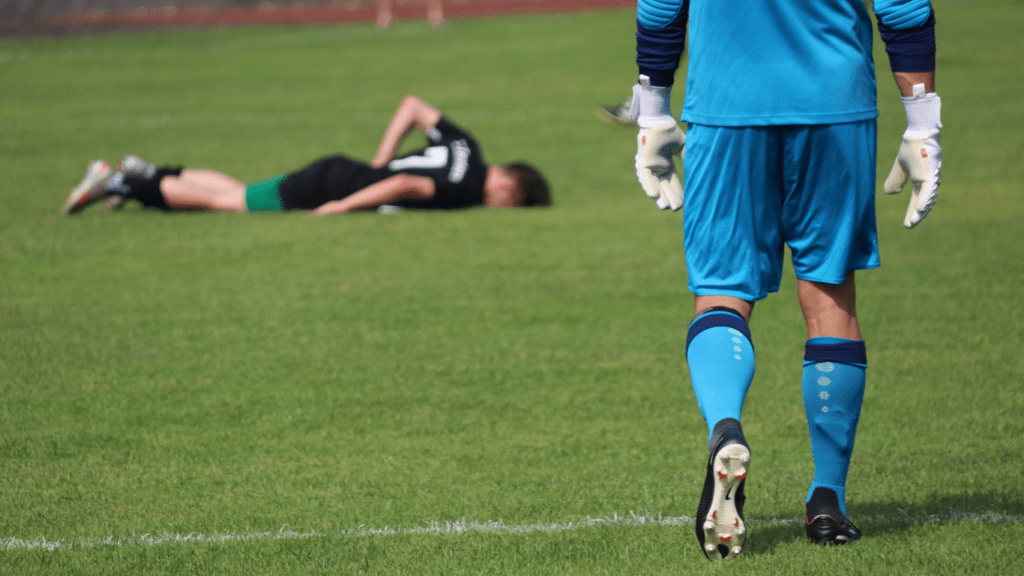Overview Of Recent Injuries
In the NFL, notable injuries include Saquon Barkley’s high ankle sprain. He’s crucial to the New York Giants’ offense. Jimmy Garoppolo’s concussion has limited the Raiders’ QB options significantly.
In the NBA, Kevin Durant’s Achilles tear continues to affect the Phoenix Suns’ performance. Zion Williamson’s knee issues keep him sidelined, impacting the New Orleans Pelicans’ playoff hopes. Ja Morant suffered an ankle injury, affecting the Memphis Grizzlies’ game plan.
In MLB, Clayton Kershaw’s shoulder injury disrupts the Dodgers’ pitching rotation. Mike Trout’s wrist fracture affects the Los Angeles Angels’ batting lineup, threatening their playoff chances. Jacob deGrom’s elbow injury concerns the Texas Rangers’ starting pitcher depth.
In the NHL, Sidney Crosby’s upper-body injury impacts the Pittsburgh Penguins’ offensive strategy. Connor McDavid’s groin strain has Edmonton Oilers’ fans worried about their star forward.
In tennis, Rafael Nadal’s hip injury restricts his Grand Slam appearances. Emma Raducanu’s wrist troubles sideline her during critical tournaments.
Key Injuries In Major Sports Leagues
Staying updated on key injuries can offer insights into team strategies and player performances. Currently, several major sports leagues face significant injuries impacting their respective teams.
- NFL
I noted Saquon Barkley’s high ankle sprain significantly affecting the New York Giants’ offensive capabilities. With Jimmy Garoppolo’s concussion, the Raiders face uncertainty at quarterback, potentially altering their game plans.
- NBA
The Brooklyn Nets struggle without Kevin Durant due to his Achilles tear, limiting their scoring options. Zion Williamson’s knee issues keep the Pelicans from reaching their full potential. Ja Morant’s ankle injury adds pressure on the Grizzlies’ roster depth, impacting their defensive strategies.
- MLB
Clayton Kershaw’s shoulder injury disrupts the Dodgers’ rotation, potentially affecting their playoff push. Mike Trout’s wrist fracture hampers the Angels’ playoff hopes. Jacob deGrom’s elbow injury raises concerns for the Rangers’ pitching depth, leading to strategic adjustments.
- NHL
Sidney Crosby’s upper-body injury leaves a gap in the Penguins’ leadership and offense. Connor McDavid’s groin strain limits the Oilers’ attacking dynamism, causing adjustments in their lineup.
Impact On Teams And Players

The injury updates significantly influence both team dynamics and individual careers in sports. Teams need to adapt quickly while players face uncertain futures.
Team Performance
Injuries to star players force teams to adjust their strategies. The New York Giants, facing the challenge of Saquon Barkley’s absence, must rely more on backup running backs and the passing game. Similarly, the Raiders’ uncertainty at quarterback due to Jimmy Garoppolo’s concussion puts pressure on the offensive line and coach’s play-calling.
In the NBA, Kevin Durant’s Achilles tear is a massive blow to the Brooklyn Nets. They now depend more heavily on secondary players to fill the void. Zion Williamson’s knee issues similarly obstruct the Pelicans’ growth, disrupting their offensive schemes.
The MLB teams aren’t immune either. The Dodgers must now navigate their rotation without Clayton Kershaw, while the Angels’ playoff hopes dim due to Mike Trout’s fractured wrist. The Rangers face a pitching dilemma as Jacob deGrom’s elbow injury raises significant concern about their rotation depth.
NHL teams like the Penguins and Oilers also suffer from critical player injuries. Sidney Crosby’s upper-body injury leaves a leadership vacuum in the Penguins’ lineup while Connor McDavid’s groin strain forces the Oilers to revisit their attacking strategy.
Player Careers
Injuries also jeopardize players’ careers, creating long-term impacts on their performance and market value. Saquon Barkley’s high ankle sprain could affect his future effectiveness and contract negotiations. Jimmy Garoppolo’s concussion history may raise red flags for his career prospects.
Kevin Durant’s Achilles tear, one of the more severe injuries in basketball, threatens his longevity and performance level in the NBA. Zion Williamson’s recurring knee problems may impact his potential, hindering what could have been a stellar career.
In MLB, Clayton Kershaw and Mike Trout face uncertain future seasons with shoulder and wrist injuries, respectively. Jacob deGrom’s elbow injury could deter teams from extending long-term contracts, affecting his career trajectory.
In NHL, Sidney Crosby’s leadership and playing style may be compromised by his upper-body injury while Connor McDavid’s performance might be subdued due to his groin strain. For tennis professionals like Rafael Nadal and Emma Raducanu, their injuries pose significant risks to ongoing success and career milestones.
Rehabilitation And Recovery
Rehabilitation and recovery play a crucial role in athletes’ return to peak performance. Understanding the latest medical advances and recovery timelines provides insights into their journey back to the field or court.
Latest Medical Advances
Modern sports medicine continually evolves, adopting new technologies and techniques. Platelet-rich plasma (PRP) therapy, which uses a concentration of a patient’s own platelets to accelerate healing, is gaining popularity. For instance, NFL players like Saquon Barkley use PRP for faster recovery from injuries such as high ankle sprains. Similarly, NBA athletes leverage cryotherapy, which exposes the body to extremely cold temperatures to reduce inflammation and pain, enhancing their recovery process.
Stem cell therapy, another cutting-edge treatment, aids in tissue regeneration and repair. Jacob deGrom of MLB is exploring this option for his elbow injury. Additionally, advancements in surgical techniques, such as minimally invasive arthroscopy, allow for quicker recovery times and reduced risk of complications. These medical advances ensure athletes have access to the best possible care and rehabilitation options.
Recovery Timelines
Recovery timelines vary based on the injury type and severity. For example, high ankle sprains like Barkley’s typically require 4-6 weeks of rehabilitation, while more severe cases might extend beyond two months. Concussions, as seen with Jimmy Garoppolo, demand a more cautious approach, often sidelining players for one to several weeks depending on the symptoms’ persistence.
Achilles tears, such as Kevin Durant’s, involve a lengthy recovery of 9-12 months due to the complexity of the tendon repair. In contrast, Zion Williamson’s knee issues might see a shorter timeline of 6-8 weeks, contingent on the extent of the ligament damage. For shoulder injuries like Clayton Kershaw’s, recovery spans 4-6 weeks for minor cases, but severe injuries could necessitate surgery extending recovery to several months.
These timelines emphasize that while medical advances boost recovery processes, patience and careful management remain integral to successful rehabilitation.
Preventative Measures
Preventative measures are vital in reducing injury risks. Focusing on proper training and utilizing advancements in equipment can help athletes stay in the game.
Injury Prevention Programs
Injury prevention programs are essential for athlete longevity. These structured plans often include:
- Strength Training: Programs focusing on muscle strengthening decrease injury risks by improving stability and resilience.
- Flexibility Exercises: Regular stretching exercises reduce muscle tightness, lowering the chance of strains.
- Proper Warm-ups: Adequate warm-up routines prepare muscles and joints for intense activity.
- Technique Training: Correct techniques minimize unnecessary strain on muscles and joints during sports activities.
Several professional sports teams have integrated these elements into their daily practices to avoid common injuries like sprains, tears, and fractures.
Innovations In Sports Equipment
Innovations in sports equipment significantly contribute to injury prevention. Key advancements include:
- Protective Gear: Modern helmets, mouthguards, and pads offer enhanced protection, reducing the risk of concussions and fractures.
- Footwear Technology: Specialized shoes provide better support and stability, preventing ankle and knee injuries.
- Wearable Tech: Devices like fitness trackers and performance monitors help detect and prevent overtraining. They offer real-time feedback on physical condition.
- Surface Materials: Improved court and field materials decrease impact forces, reducing joint and muscle injuries.
Athletes using cutting-edge equipment can see a substantial reduction in injury rates, promoting longer and healthier careers.


 Pedro Brandon played a crucial role in developing the content strategy for Bet Roll Gamble, ensuring the platform offers timely, accurate, and engaging insights across sports betting, poker, horse racing, and esports. His ability to identify trends and curate relevant content has helped attract a diverse audience, providing bettors with the strategies and updates they need to stay competitive.
Pedro Brandon played a crucial role in developing the content strategy for Bet Roll Gamble, ensuring the platform offers timely, accurate, and engaging insights across sports betting, poker, horse racing, and esports. His ability to identify trends and curate relevant content has helped attract a diverse audience, providing bettors with the strategies and updates they need to stay competitive.